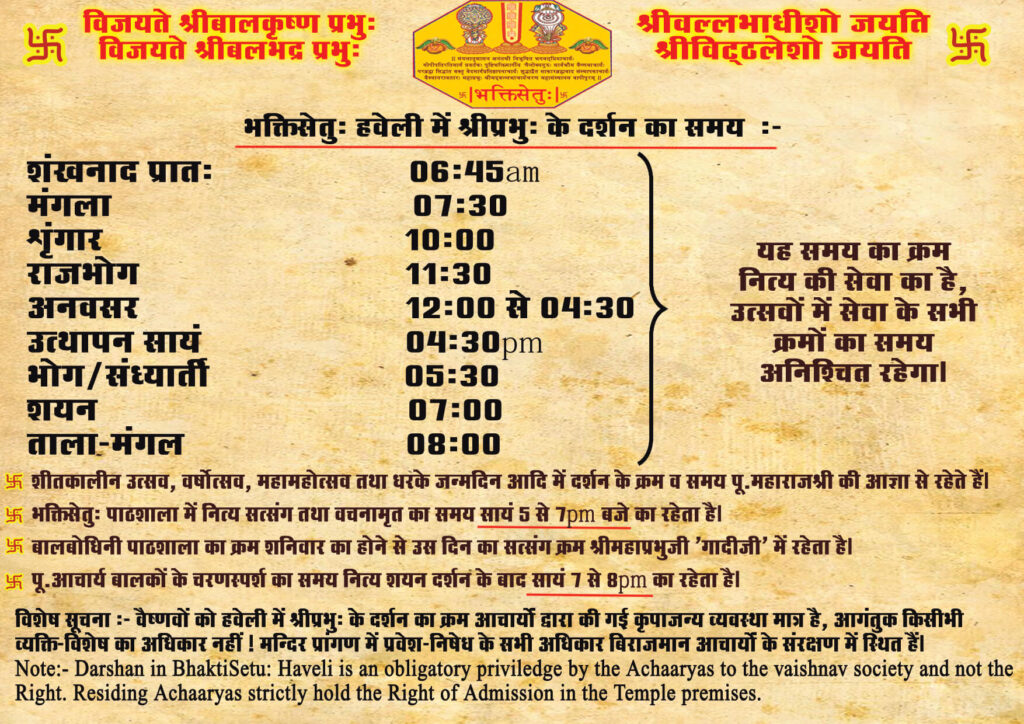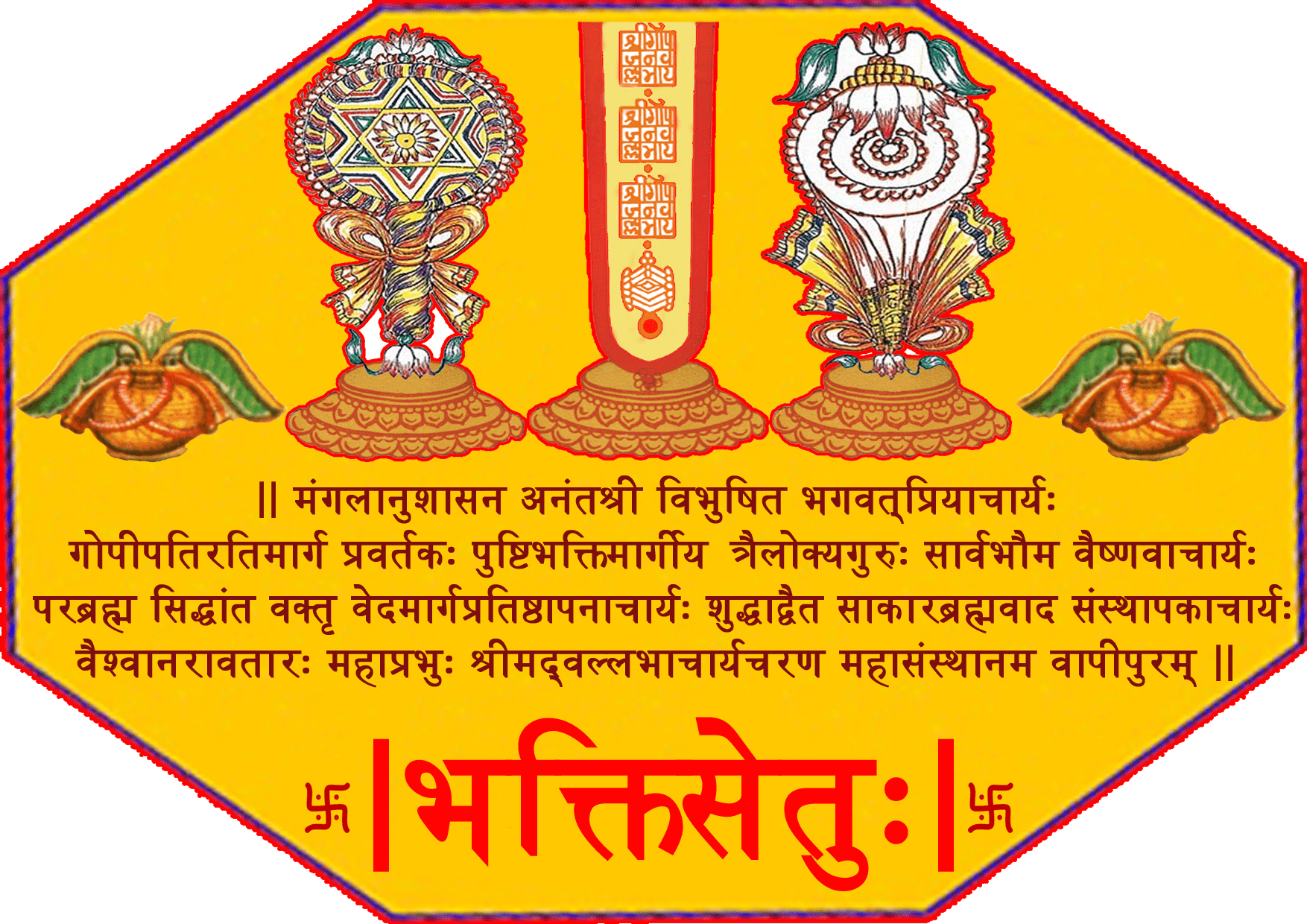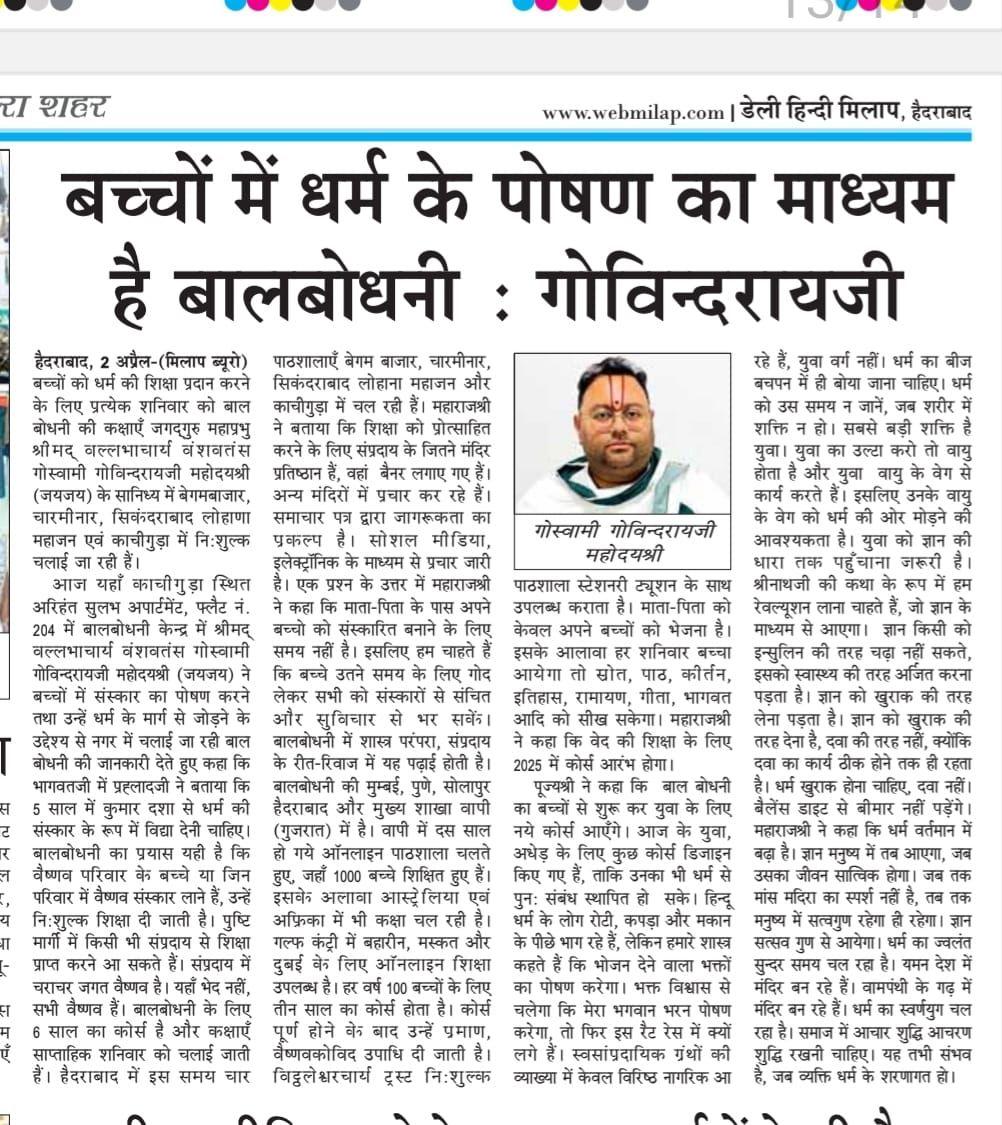






Welcome to Bhaktisetu Haveli
By the infinite grace of Prabhu Shri Balkrishnalal and Shri Daudayal Prabhu, With the divine blessings of Jagadguru Mahaprabhu Shri Vallabhacharyacharan and Prabhucharan Gusainji Shri Vitthalnathaji on the auspicious day of Aashaadh Shukhla Chaturthi (4) Vikram Samvat 2063 Vallabhaabd 529, 29th June 2006,.
The sacred establishment of Bhaktisetu Haveli came into existence by the efforts and vision of Goswami 108Shri Neerajkumarji Madhavraiji Maharajshri (Mumbai-Vapi).
Bhaktisetu Haveli, an Acharya-niwas upholds the legacy and tradition of Pushtimargiya Seva Prakar with the Pranalika of “Shri Navneetpriyaji Ke Ghar Ki Seva Bhavana” – Nathdwara, which is practiced and observed in the Sewakram of Prabhu Shri Balkrishnalal – Shri Daudayal Prabhu with the Palangadiji of Shri Gusainji.
As the main Nidhiswaroop of Shri Vapi haveli and core of the heart being the family deity of Shriman Madhavraiji Gokulnathji Maharajshri.
Bhaktisetu Haveli runs a socio-religious organization and charitable institution such as Vitthaleshacharya Trust with its main activities of Pushtimargiya Vaishnav School, Baalbodhini Paathshala and also a research wing in the philosophical school of thought as V.A.P.I. (Vallabh Academy of Pushtimargiya Intelligence).
Bhaktisetu Haveli helps many Gaushalas by Charitable drives and funding’s.
Bhaktisetu Haveli was blessed to enshrine Nidhiswaroop of Shri Kunwarlaadilelaal with Chhote Nidhiswaroop and Palangadiji of Shri Mahaprabhuji in the sanctum-sanctorum of the temple premises for the past 15 years, which belongs to H.H. Shri Manmathraiji Uttamshlokji Maharaj presently in-housed at Nandbhavan Haveli, Mira Road, Mumba
Mohini Ekaadashi :: Vaishakh Shukla Ekaadashi || By Shri Govindraiji ||
Download Seva Pranalika
Download Bhaktisetu Tippani 2082
(To view both files you need to have Adobe Reader Software)

What is Pushtimarg?
Pushtimarg: The Path of Graceful Devotion
Pushtimarg is a path of devotion to Lord Krishna, which originated in the 16th century in the Indian state of Gujarat. The term Pushtimarg means “the path of nourishment” and “the path of grace”. It reflects the vitality of accepting Lord Krishna’s grace with devotional practices.
The founder of Pushtimarg was the great saint and scholar Vallabhacharya, who taught that the ultimate goal of human life is to attain the grace of Lord Krishna, which can be achieved through bhakti or loving devotion. According to Vallabhacharya, bhakti is not just a feeling or an emotion but a complete way of life that involves surrendering oneself to the divine will of Lord Krishna.
Pushtimarg’s practice includes numerous everyday rituals, including Lord Krishna’s worship in the form of an image or deity, the singing of hymns and prayers, and the recitation of the sacred text. Pushtimarg’s followers also observe strict rules of cleanliness and purity, including regular bathing and dietary rules.
The focus on seva or selfless service to Lord Krishna is one of the dominant aspects of Pushtimarg. The followers believe that they can acquire grace and get closer to Lord Krishna by serving him with humility and devotion. Seva can be in numerous forms, such as cooking, decorating Lord Krishna’s image, offering food to him, and cleaning his temple.
Pushtimarg comes with a rich tradition of devotional literature, including Vallabhacharya’s works and his disciples. Sri Bhagavata Purana is one of his most famous works. It is a sacred text that tells the story of Lord Krishna’s life and teachings. Pushtimarg’s followers also celebrate many festivals across the year, such as Janmashtami, Lord Krishna’s birthday, and Holi, the festival of colors.
Now, Pushtimarg has followers worldwide. Its teachings keep inspiring people to lead a life of devotion and service to Lord Krishna. The path of Pushtimarg offers a powerful way to connect with the divine and experience the grace of Lord Krishna, be it through everyday rituals, seva, or the study of sacred texts.
FAQ's on Pushtimarg
Shree Vallabh Sampraday known as Pushtimarg was found in the early 16th century by Shree Vallabhacharyaji, a Vailyanaadu Telang Brahmin from Kaankarwaad, Telangana. The followers of Pushtimarg are known as Vaishnavs and they believe Krishna is the Supreme power and they live a Krishna-centric life.
Vaishnavs serve Krishna with the best of everything and their love for Krishna is selfless and expect nothing in return but more opportunities to be in Seva and expect to be a part of Leela of Shree Thakorji and attain Golok Dham.
The main temple of the Pushtimarg sect is the Shrinathji Temple, located in Nathdwara, Rajasthan, India. This temple is considered the primary and most significant pilgrimage site for followers of Pushtimarg. The deity worshipped in this temple is Shrinathji, a child form of Lord Krishna aged between 7-11 years.
Brahmasambandh in Pushtimarg is a sanskar. It’s an alaukik experience of establishing a connection with Shree Thakorji in presence of Vallabhkul aacharya. Where in the Vaishnav in APRAS condition takes a tulsidal in his hand and surrenders himself and all his belongings in the pious charnaarvind of Shree Thakorji and in return Shree Thakorji also promises to nivrut him of all the doshas and accept him and his services and keep him under Aapshree’s sharan forever.
The Ashtakshara Mantra or the 8 letter mantra,which is first given(नाम निवेदन) to the devotee who comes under Lord Shri Krishna, is no ordinary mantra. It has divine capabalities. The mantra says ” श्रीकृष्ण: शरणं मम ” literally meaning “Shri Krishna is my shelter.”
Note:
The Blog and FAQs uploaded on the website portal are the compilations of Pushtimargeeya information available on social media and AI resources compiled by the Vaishnav volunteers of Bhaktisetu: Haveli. For proper learning, understanding and practice of Pushtimarg kindly approach Pujya Jejeshri personally.


